The Micro-Liposome Delivery Market is expected to record a valuation of USD 1,562.3 million in 2025 and USD 5,321.4 million in 2035, with an increase of USD 3,759.1 million, which equals a growth of ~193% over the decade. The overall expansion represents a CAGR of 13.0% and a near 2X increase in market size.
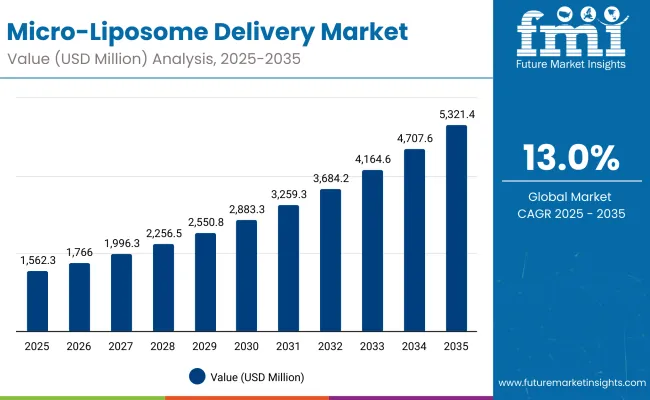
Micro-Liposome Delivery Market Key Takeaways
| Metric | Value |
|---|---|
| Market Estimated Value in (2025E) | USD 1,562.3 million |
| Market Forecast Value in (2035F) | USD 5,321.4 million |
| Forecast CAGR (2025 to 2035) | 13.0% |
During the first five-year period from 2025 to 2030, the market increases from USD 1,562.3 million to USD 2,883.3 million, adding USD 1,321.0 million, which accounts for 35% of the total decade growth. This phase records steady adoption of serums and clinical-grade products, with consumer trust in efficacy and dermatology-backed formulations driving demand.
The second half from 2030 to 2035 contributes USD 2,438.1 million, equal to 65% of total growth, as the market jumps from USD 2,883.3 million to USD 5,321.4 million. This acceleration is powered by the mainstreaming of advanced delivery systems in anti-aging, skin repair, and brightening, alongside growing traction in Asia-Pacific markets. Expanding e-commerce penetration, sustainability-linked claims, and premiumization trends further push the segment into higher-value territory.
From 2020 to 2024, the Micro-Liposome Delivery Market steadily expanded, with demand shaped by anti-aging, enhanced absorption, and clinical-grade claims. Growth was fueled by the rising adoption of serums and ampoules, backed by scientific validation and consumer demand for efficacy. By 2025, the market is set to surpass USD 1.56 billion, with clinical-grade and natural/clean-label claims driving differentiation. Over the next decade, revenue expansion will be increasingly supported by e-commerce, premiumization trends, and innovation in targeted delivery formulations, shifting the competitive advantage toward brands emphasizing science-backed, transparent, and sustainable strategies.
The market is expanding due to growing demand for formulations that enhance absorption at the cellular level. Micro-liposomes encapsulate active ingredients, improving stability, bioavailability, and controlled release. This unique capability positions them as superior carriers in anti-aging and brightening products, where consumers expect faster visible results. The ability to deliver actives deeper into the skin is reshaping premium skincare innovation.
Growth is driven by the surge in clinical-grade skincare, where consumers prioritize science-backed efficacy. Micro-liposome delivery systems align with this shift by enabling dermatologist-tested formulations with higher penetration efficiency. Brands are leveraging micro-liposomes in serums and ampoules to meet regulatory and consumer expectations for measurable outcomes. This performance-oriented positioning is elevating micro-liposome products from niche applications to mainstream skincare adoption.
The market is segmented by function, product type, channel, claim, and region. Functions include enhanced absorption, anti-aging, brightening, and skin repair, reflecting the wide applications of micro-liposome delivery in skincare formulations. Product type segmentation covers serums, creams/lotions, ampoules, and gels, with serums leading adoption due to their compatibility with concentrated actives and advanced delivery systems.
Based on distribution channel, the market includes pharmacies, e-commerce, specialty beauty stores, and mass retail, highlighting the balance between professional-grade access and mainstream consumer availability. In terms of claim, the market is divided into clinical-grade, dermatologist-tested, vegan, and clean-label formulations, underscoring the increasing demand for transparency, safety, and ethical sourcing. Regionally, the scope spans North America, Europe, East Asia, South Asia & Pacific, Latin America, and the Middle East & Africa. Country-level highlights include strong growth trajectories in China, India, Japan, Germany, the UK, and the USA, each shaped by unique consumer trends, regulatory environments, and retail ecosystems.
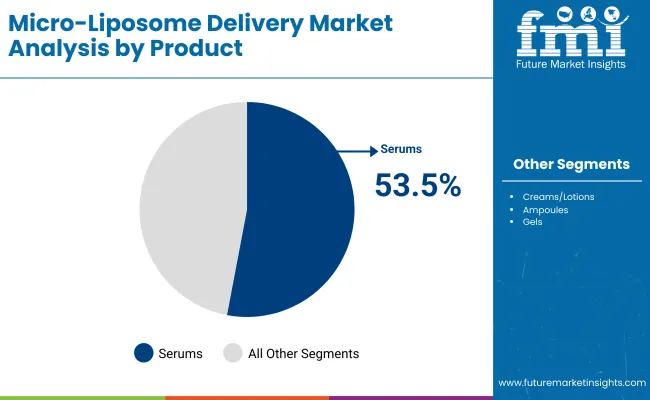
| Product | Value Share% 2025 |
|---|---|
| Serums | 53.5% |
| Others | 46.5% |
The serums segment is projected to contribute 53.5% of the Micro-Liposome Delivery Market revenue in 2025, maintaining its lead as the dominant product type. This is driven by strong consumer demand for lightweight, fast-absorbing formulations that can effectively deliver encapsulated actives deep into the skin. Serums provide the optimal format for micro-liposome integration, enhancing efficacy in anti-aging, brightening, and skin repair applications.
The segment’s growth is further supported by premiumization trends, where serums are positioned as high-value products with clinical-grade validation. Their compatibility with both retail and professional channels ensures widespread adoption. As personalization and targeted skincare gain traction, serums are expected to remain the backbone of micro-liposome delivery solutions.
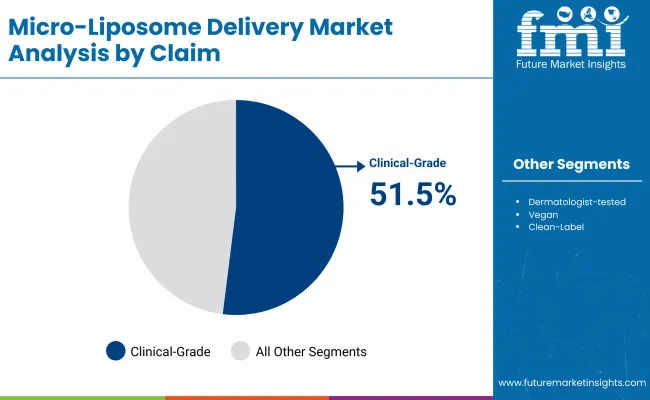
| Claim | Value Share% 2025 |
|---|---|
| Clinical-grade | 51.5% |
| Others | 48.5% |
The clinical-grade segment is forecasted to account for 51.5% of Micro-Liposome Delivery Market revenues in 2025, positioning it as the leading claim category. Clinical-grade products are trusted for their scientifically validated efficacy, offering higher absorption and consistent results that appeal to both dermatologists and consumers seeking professional-grade skincare.
This dominance is reinforced by the shift toward evidence-backed formulations that address anti-aging, brightening, and skin repair needs. Growing partnerships between dermatology clinics and premium skincare brands are expanding awareness and adoption. As demand for results-driven skincare accelerates, clinical-grade micro-liposome products are expected to remain at the forefront of market growth.
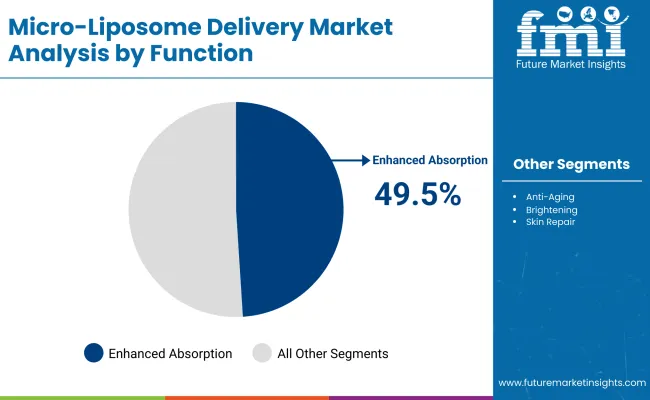
| Function | Value Share% 2025 |
|---|---|
| Enhanced absorption | 49.5% |
| Others | 50.5% |
The enhanced absorption function is projected to contribute 49.5% of the Micro-Liposome Delivery Market revenue in 2025, establishing it as a leading functional application. Micro-liposome delivery excels in improving the bioavailability of active ingredients, ensuring deeper skin penetration and prolonged release for visible results. This makes it highly relevant in anti-aging, brightening, and reparative skincare.
Its dominance is supported by consumer demand for high-performance products that offer measurable benefits beyond traditional formulations. With clinical validation reinforcing trust, enhanced absorption is set to remain central to the positioning of micro-liposome-based serums, creams, and ampoules throughout the forecast period.
Rising Preference for High-Efficacy Skincare Formulations
Consumers are increasingly prioritizing skincare products with proven efficacy, driving the adoption of micro-liposome delivery systems. These systems enhance the absorption and stability of active ingredients, enabling visible and long-lasting results in anti-aging, brightening, and repair categories. With demand shifting toward performance-driven skincare, brands are investing heavily in liposome-based serums and ampoules. Clinical validation and dermatologist endorsements further strengthen consumer trust, ensuring micro-liposome formulations are perceived as both premium and effective, thereby fueling consistent market growth across regions.
Expansion of Clinical-Grade and Professional Skincare
The rapid rise of clinical-grade skincare is fueling demand for micro-liposome delivery. Dermatologists and professional clinics increasingly prescribe and recommend products incorporating these delivery systems due to their precision and enhanced bioavailability. This alignment between science-backed claims and consumer expectations creates opportunities for premium pricing. The segment’s leadership is supported by growing collaboration between cosmetic brands and medical professionals, leading to hybrid offerings positioned between traditional skincare and dermatology solutions, making micro-liposome products indispensable in modern, results-driven skincare routines.
High Development and Formulation Costs
Despite their benefits, micro-liposome delivery systems face cost-related barriers. Manufacturing liposome-based formulations requires advanced technology, specialized ingredients, and strict quality control, which significantly increases production costs. These expenses limit accessibility for mass-market brands and make final products less affordable for cost-sensitive consumers. Moreover, ensuring stability and scalability during production adds complexity, reducing the speed of market entry. This cost-intensive structure restricts the participation of smaller brands, concentrating growth opportunities among established players with resources to invest in innovation and premium positioning.
Premiumization Through Personalized Skincare Solutions
An emerging trend is the integration of micro-liposome delivery systems into personalized skincare regimes. With consumers demanding tailored solutions for anti-aging, hydration, and skin repair, brands are leveraging AI skin diagnostics and e-commerce platforms to customize formulations. Micro-liposomes enhance this approach by ensuring active ingredients are delivered effectively, boosting the perceived value of personalization. This trend is accelerating premiumization, as consumers are willing to pay higher prices for bespoke, clinically validated products. The fusion of personalization and micro-liposome technology is reshaping skincare innovation.
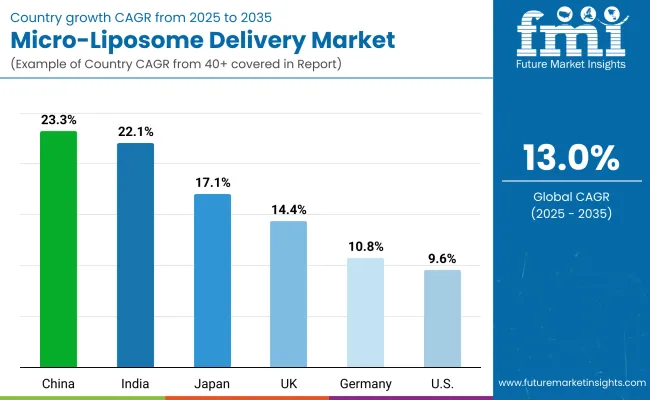
| Countries | Estimated CAGR (2025 to 2035) |
|---|---|
| China | 23.3% |
| USA | 9.6% |
| India | 22.1% |
| UK | 14.4% |
| Germany | 10.8% |
| Japan | 17.1% |
The global Micro-Liposome Delivery Market shows strong regional disparities in adoption, shaped by consumer preferences, regulatory frameworks, and the maturity of beauty and personal care industries. Asia-Pacific is the fastest-growing region, anchored by China (23.3% CAGR) and India (22.1% CAGR). In China, demand is driven by e-commerce-led sales, premium skincare consumption, and rapid acceptance of clinical-grade products. India’s expansion reflects rising middle-class consumption, growing awareness of functional skincare, and the rollout of micro-liposome products into tier-2 and tier-3 cities. Japan (17.1% CAGR) adds further momentum through strong anti-aging and brightening demand, particularly in premium beauty categories.
Europe maintains a robust profile, with Germany (10.8% CAGR) and the UK (14.4% CAGR) leading adoption. Both countries benefit from consumer preference for clean-label, clinically validated skincare and wide retail availability. Germany’s aging population drives anti-aging demand, while the UK favors premium, natural formulations in specialty stores. North America shows steady but moderate growth, with the USA at 9.6% CAGR. The market here is shaped by high penetration of natural/organic claims, strong dermatology-backed endorsements, and consumer willingness to pay for premium formulations, though growth is slower compared to Asia-Pacific’s rapid expansion.
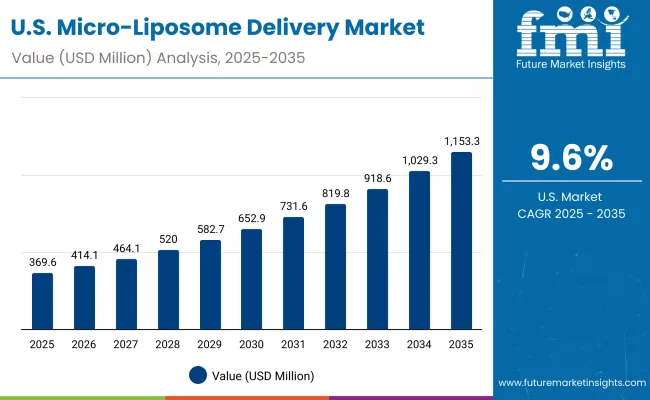
| Year | USA Micro-Liposome Delivery Market (USD Million) |
|---|---|
| 2025 | 369.63 |
| 2026 | 414.18 |
| 2027 | 464.10 |
| 2028 | 520.03 |
| 2029 | 582.71 |
| 2030 | 652.94 |
| 2031 | 731.63 |
| 2032 | 819.81 |
| 2033 | 918.62 |
| 2034 | 1,029.33 |
| 2035 | 1,153.39 |
The Micro-Liposome Delivery Market in the United States is projected to grow at a CAGR of 9.6%, rising from USD 369.6 million in 2025 to USD 1,153.4 million by 2035. Growth is primarily driven by consumer preference for clinical-grade and dermatologist-tested formulations, which dominate claim-based adoption. The USA market also benefits from strong distribution through pharmacies, dermatology clinics, and e-commerce platforms, ensuring wide access to serums, creams, and ampoules incorporating micro-liposome systems.
The Micro-Liposome Delivery Market in the United Kingdom is expected to grow at a CAGR of 14.4% from 2025 to 2035. Growth is underpinned by strong consumer demand for premium skincare formats, especially serums and creams infused with micro-liposome technology. Clean-label, vegan, and sustainable sourcing claims resonate strongly in the UK market, driving adoption across both specialty beauty stores and e-commerce platforms. Anti-aging and brightening functions are gaining momentum, supported by high consumer spending on wellness and dermatology-backed skincare.
India is witnessing rapid growth in the Micro-Liposome Delivery Market, which is forecast to expand at a CAGR of 22.1% through 2035. Expansion is fueled by rising disposable incomes, growing middle-class adoption of premium skincare, and strong cultural alignment with herbal and plant-based beauty solutions. Tier-2 and tier-3 cities are emerging demand hubs as e-commerce platforms make micro-liposome serums, creams, and ampoules more accessible. Clinical-grade positioning and dermatology partnerships are further driving awareness and credibility.
The Micro-Liposome Delivery Market in China is expected to grow at a CAGR of 23.3%, the highest among leading economies. This momentum is driven by the strong dominance of e-commerce (55.3% share in 2025), competitive innovations from domestic beauty brands, and growing acceptance of clinical-grade skincare. Affordable serums and ampoules are rapidly expanding access beyond tier-1 cities, reaching younger consumers in tier-2 and tier-3 markets. Anti-aging and brightening functions are particularly popular, reflecting rising middle-class spending on wellness and aesthetics.
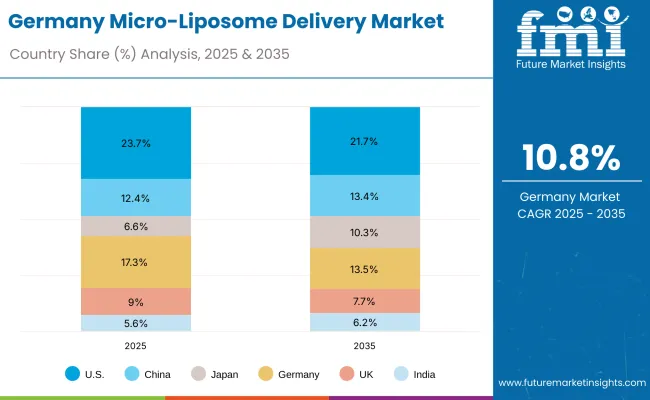
| Countries | 2025 Share (%) |
|---|---|
| USA | 23.7% |
| China | 12.4% |
| Japan | 6.6% |
| Germany | 17.3% |
| UK | 9.0% |
| India | 5.6% |
| Countries | 2035 Share (%) |
|---|---|
| USA | 21.7% |
| China | 13.4% |
| Japan | 10.3% |
| Germany | 13.5% |
| UK | 7.7% |
| India | 6.2% |
The Micro-Liposome Delivery Market in Germany is projected to grow at a CAGR of 10.8%, though its global share is expected to decline from 17.3% in 2025 to 13.5% in 2035 as Asia-Pacific accelerates. Growth in Germany is underpinned by strong consumer demand for clinical-grade and clean-label skincare, coupled with the country’s aging population fueling anti-aging and repair product adoption. Pharmacies and specialty beauty stores dominate distribution, while sustainability-linked claims resonate with eco-conscious consumers.
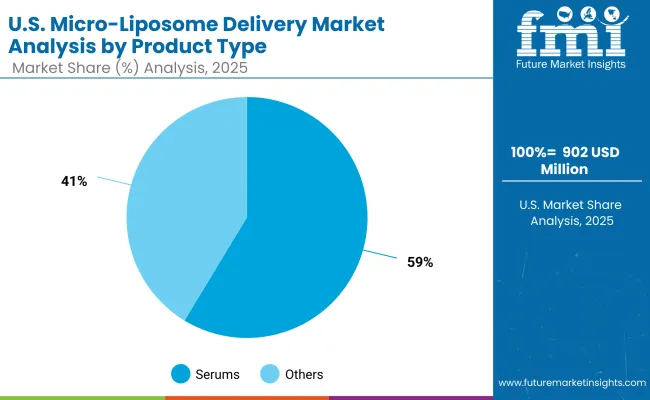
| USA by Product Type | Value Share% 2025 |
|---|---|
| Serums | 58.7% |
| Others | 41.3% |
The Micro-Liposome Delivery Market in the USA is projected to expand steadily at a CAGR of 9.6% from 2025 to 2035. Serums dominate with 58.7% share in 2025, reflecting consumer preference for concentrated, results-driven formats that integrate micro-liposome technology for enhanced absorption and efficacy. Growth is also supported by strong demand for clinical-grade formulations, widespread availability through pharmacies and dermatology clinics, and rising online sales. The USA market is increasingly shaped by consumer willingness to invest in premium, dermatologist-tested skincare solutions.
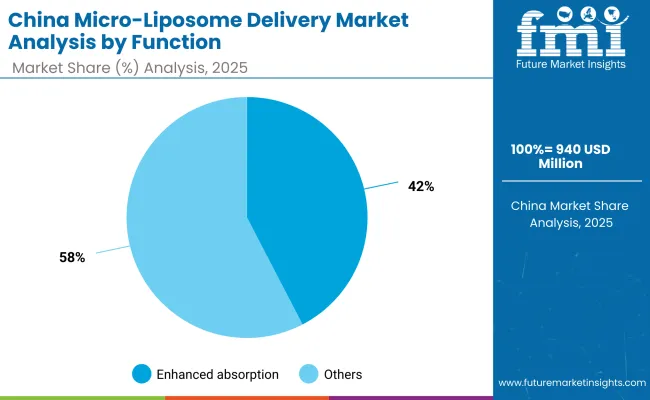
| China by Function | Value Share% 2025 |
|---|---|
| Enhanced absorption | 42.4% |
| Others | 57.6% |
The Micro-Liposome Delivery Market in China is expected to expand at a CAGR of 23.3%, the highest among leading economies. Enhanced absorption, with a 42.4% share in 2025, represents a major growth opportunity as Chinese consumers increasingly prioritize high-efficacy skincare backed by clinical-grade claims. Domestic brands are capitalizing on this trend by launching cost-effective serums and ampoules, while international players target premium segments with advanced formulations. E-commerce dominance and social commerce platforms provide unmatched scalability, positioning China as the global growth engine for micro-liposome delivery adoption.
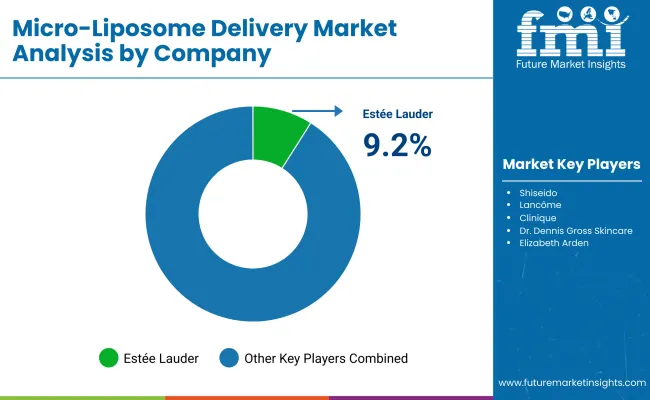
The Micro-Liposome Delivery Market is moderately fragmented, with global leaders, mid-sized innovators, and niche-focused beauty specialists competing across various skincare functions such as anti-aging, brightening, and enhanced absorption. Estée Lauder, with a 9.2% global share, leads the market by integrating micro-liposome delivery into high-value serums and creams under its premium skincare portfolio. Other international leaders such as Shiseido, Lancôme, and Clarins are also accelerating innovation in liposome-based formulations, targeting anti-aging and clinical-grade positioning.
Mid-sized players like Clinique, Dr. Dennis Gross Skincare, and Obagi are strengthening their presence with dermatology-backed, clinical-grade offerings that appeal to results-driven consumers. Meanwhile, niche-focused brands such as Murad, Biotherm, and Elizabeth Arden are differentiating through hybrid claims, combining clean-label positioning with science-backed performance. Competitive differentiation is increasingly shifting toward clinical validation, sustainability-linked claims, and e-commerce-driven consumer engagement. The long-term advantage lies less in brand legacy alone and more in the ability to scale through personalized formulations, transparent sourcing, and digital-first distribution models.
Key Developments in Micro-Liposome Delivery Market
| Item | Value |
|---|---|
| Quantitative Units | USD 1,562.3 Million |
| Function | Enhanced absorption, Anti-aging, Brightening, Skin repair |
| Product Type | Serums, Creams/lotions, Ampoules, Gels |
| Channel | Pharmacies, E-commerce, Specialty beauty stores, Mass retail |
| Claim | Clinical-grade, Dermatologist-tested, Vegan, Clean-label |
| Regions Covered | North America, Europe, Asia-Pacific, Latin America, Middle East & Africa |
| Country Covered | United States, Canada, Germany, France, United Kingdom, China, Japan, India, Brazil, South Africa |
| Key Companies Profiled | Estée Lauder, Shiseido, Lancôme, Clinique, Dr. Dennis Gross Skincare, Elizabeth Arden, Clarins, Biotherm, Obagi, Murad |
| Additional Attributes | Dollar sales by scanner type and end-use industry, adoption trends in reverse engineering and quality control, rising demand for handheld and portable 3D scanners, sector-specific growth in aerospace, automotive, and healthcare, software and services revenue segmentation, integration with AR/VR and digital twin technologies, regional trends influenced by digitization initiatives, and innovations in laser triangulation, structured light, and photogrammetry methods. |
The global Micro-Liposome Delivery Market is estimated to be valued at USD 1,562.3 million in 2025.
The market size for the Micro-Liposome Delivery Market is projected to reach USD 5,321.4 million by 2035.
The Micro-Liposome Delivery Market is expected to grow at a 13.0% CAGR between 2025 and 2035.
The key product types in the Micro-Liposome Delivery Market are Serums, Creams/lotions, Ampoules, and Gels.
In terms of product type, the Serums segment is projected to command a 53.5% share of the Micro-Liposome Delivery Market in 2025, making it the leading category.
Explore Similar Insights

Thank you!
You will receive an email from our Business Development Manager. Please be sure to check your SPAM/JUNK folder too.
Chat With
MaRIA